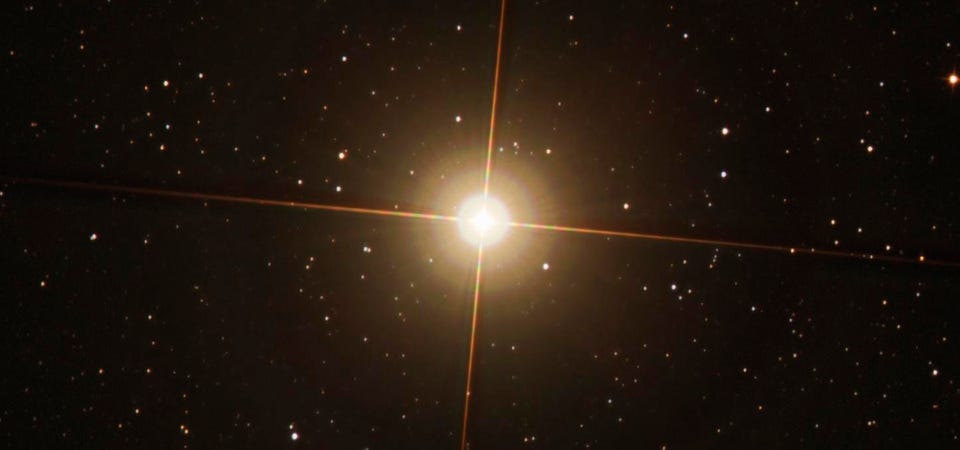Science Betelgeuse Blew Its Top: Hubble Sees Red Supergiant Star ‘Bouncing’ After Catastrophic Upheaval Jamie Carter Senior Contributor Opinions expressed by Forbes Contributors are their own. I inspire people to go stargazing, watch the Moon, enjoy the night sky New! Follow this author to stay notified about their latest stories. Got it! Aug 13, 2022, 08:00pm EDT | New! Click on the conversation bubble to join the conversation Got it! Share to Facebook Share to Twitter Share to Linkedin Data from NASA’s Hubble Space Telescope shows that bright red supergiant star Betelgeuse “blew its .
. . [+] top” in 2019, losing a substantial part of its visible surface and producing a gigantic Surface Mass Ejection (SME).
getty Did Betelgeuse explode already? If you remember Betelgeuse’s “great dimming” in late 2019 and early 2020 then you’ll know that the famous red supergiant star’s status has been a hot topic in astronomy of late. Now new data from NASA’s Hubble Space Telescope shows that its unexpected dimming was most likely caused by its “ blowing its top ” in 2019, during which it lost a big part of its surface. What scientists are called a surface mass ejection (SME) from Betelgeuse is something never before observed.
A bright red supergiant star in our galaxy that’s near the end of its life, Betelgeuse likely will explode as a supernova and be visible in the daytime sometime in the next 100,000 years. A supernova hasn’t been seen in our galaxy since the 17th century. Scientists don’t expect Betelgeuse’s weird behavior to result in a supernova explosion anytime soon, but they are perplexed about what’s happening to the most famous star in the constellation of Orion.
Our own star, the Sun, sometimes launches huge clouds of plasma into space called coronal mass ejections (CMEs). At Betelgeuse it’s at an incredible scale with its SME estimated to blast off 400 billion times as much mass. MORE FOR YOU New Research Finds A Connection Between Domestic Violence And These Two Personality Disorders This Scientist Helps Andean Forests And Ecuador’s Women In STEM Exceptional Fossil Preservation Suggests That Discovering Dinosaur DNA May Not Be Impossible “We’ve never before seen a huge mass ejection of the surface of a star.
We are left with something going on that we don’t completely understand,” said Andrea Dupree of the Center for Astrophysics, Harvard & Smithsonian in Cambridge, Massachusetts. “It’s a totally new phenomenon that we can observe directly and resolve surface details with Hubble. ” Astronomers don’t often get to watch stellar evolution in real time, normally observing stars in various phases lasting for long time periods.
Nor do they often see stars “bouncing,” as Betelgeuse appears to now be doing. “Betelgeuse continues doing some very unusual things right now; the interior is sort of bouncing,” said Dupree. This illustration plots changes in the brightness of the red supergiant star Betelgeuse, following .
. . [+] the titanic mass ejection of a large piece of its visible surface.
The escaping material cooled to form a cloud of dust that temporarily made the star look dimmer, as seen from Earth. This unprecedented stellar convulsion disrupted the monster star’s 400-day-long oscillation period that astronomers had measured for more than 200 years. The interior may now be jiggling like a plate of gelatin dessert.
NASA, ESA, Elizabeth Wheatley (STScI) Betelgeuse is thought to be recovering from its massive “burp” from within in 2019 when a bubble of gas from deep inside the star produced enough power to blast off a section of its surface, which became a dust cloud above that caused the star to appear to dim as seen from Earth. Don’t go looking for Betelgeuse in the night sky because Betelgeuse isn’t visible at the moment. It’s in the daytime sky during August, so even if it went supernova now we wouldn’t see much of it.
Betelgeuse is about 750 times the radius of our Sun and 530 light-years away, which is well beyond the 50 light-year “danger zone” for Earth if a nearby star does go supernova. Of course, Betelgeuse may have already gone supernova over 529 years ago and its light just hasn’t reached us yet. Wishing you clear skies and wide eyes.
Follow me on Twitter or LinkedIn . Check out my website or some of my other work here . Jamie Carter Editorial Standards Print Reprints & Permissions.
From: forbes
URL: https://www.forbes.com/sites/jamiecartereurope/2022/08/13/betelgeuse-blew-its-top-hubble-sees-red-supergiant-star-bouncing-after-catastrophic-upheaval/



